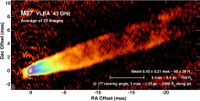The Physics of Jet Formation
 The central radio source in Messier 87 (M87) provides the best opportunity to study jet formation owing to its large angular size for the gravitational radius of the black hole and its bright jet that is well resolved by very long baseline interferometry observations. Walker et al. present intensive monitoring observations from 2007 and 2008, plus approximately annual observations that span 17 years, all conducted with the Very Long Baseline Array (VLBA) at 43 GHz with a resolution of ~30 RS x 60 RS. The high dynamic range of these images clearly show the wide opening angle structure and the counterjet. The jet and counterjet are nearly symmetric in the inner 1.5 milli-arcseconds (0.12 parsec in projection), with both being edge brightened. Both show deviations from parabolic shape in the form of an initial rapid expansion and subsequent contraction followed by further rapid expansion and, beyond the visible counterjet, subsequent collimation. Proper motions and counterjet / jet intensity ratios both indicate acceleration from apparent speeds of ≲ 0.5c to ≳ 2c in the inner ~2 milli-arcseconds and suggest a helical flow. The jet displays a sideways shift with an ~8–10 year quasi-periodicity. The shift propagates outward nonballistically and significantly more slowly than the flow speed revealed by the fastest-moving components. Polarization data show a systematic structure with magnetic field vectors that suggest a toroidal field close to the core.
The central radio source in Messier 87 (M87) provides the best opportunity to study jet formation owing to its large angular size for the gravitational radius of the black hole and its bright jet that is well resolved by very long baseline interferometry observations. Walker et al. present intensive monitoring observations from 2007 and 2008, plus approximately annual observations that span 17 years, all conducted with the Very Long Baseline Array (VLBA) at 43 GHz with a resolution of ~30 RS x 60 RS. The high dynamic range of these images clearly show the wide opening angle structure and the counterjet. The jet and counterjet are nearly symmetric in the inner 1.5 milli-arcseconds (0.12 parsec in projection), with both being edge brightened. Both show deviations from parabolic shape in the form of an initial rapid expansion and subsequent contraction followed by further rapid expansion and, beyond the visible counterjet, subsequent collimation. Proper motions and counterjet / jet intensity ratios both indicate acceleration from apparent speeds of ≲ 0.5c to ≳ 2c in the inner ~2 milli-arcseconds and suggest a helical flow. The jet displays a sideways shift with an ~8–10 year quasi-periodicity. The shift propagates outward nonballistically and significantly more slowly than the flow speed revealed by the fastest-moving components. Polarization data show a systematic structure with magnetic field vectors that suggest a toroidal field close to the core.
Image: The 23-epoch average radio image of the jet and counterjet in M87 based on data from 2007 and 2008. Angular to linear scales (in parsecs and Schwarzschild radii, RS) are indicated for distances in the sky plane and for distances along the axis of the jet assuming that it is oriented at 17° to the line-of-sight. The beam with resolution 0.43 × 0.21 milli-arcsecond elongated in position angle −16° is at lower left. The off-source noise level is 62 μJy/beam; the image peak is 0.83 Jy.
Publication: R. Craig Walker (NRAO) et al., The Structure and Dynamics of the Subparsec Jet in M87 Based on 50 VLBA Observations over 17 Years at 43 GHz, Astrophysical Journal, 855, 128 (10 March 2018).




Connect with NRAO